|






Click the flag
Meet our special
U.S. Publishers
|
Crisis
Intervention & Counseling
Featured
Books in this Category / Main
Booklist

Featured
Books

|
Adolescent Self-Injury:
a Comprehensive Guide for Counselors and Health Care Professionals. Amelio D’Onofrio, $63.50
In this truly comprehensive guide, Dr.
D'Onofrio approaches the topic of how first-responders, such as
teachers, coaches, social workers, guidance counselors, and campus
health counselors, can and do treat adolescent self-injury. Each
part of the book focuses on a basic topic, such as what constitutes
self-injury, the foundations for self-injury, and how to engage
an adolescent with these issues. Each issue is presented in straightforward
chapters that are immediately accessible to those who are currently
struggling to address this growing trend among teens. The chapters
within each part delve into how to recognize, treat, and approach
this illness and incorporate first-person stories from psychologists,
teachers, and adolescents themselves. |
|
The Adolescent & Young
Adult Self-Harming Treatment Manual: a Collaborative Strengths-Based
Brief Therapy Approach.
Mathew Selekman, $42.50
This is a practical and informative
manual that will help both experienced and beginning therapists
feel more confident and competent working with adolescent and
young self-harming clients. |

|
After a Parent’s
Suicide: Helping Children Heal. Margo Requarth, $22.95
After a Parent’s Suicide is
a compassionate guide for parent survivors on how to manage both
the immediate and the long-term implications of the suicide; how
to talk to your children and how to see them through the anguish
to a place of healing, acceptance and life. |
Back to top
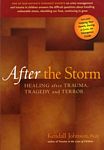
|
After
the Storm: Healing after Trauma, Tragedy and Terror. Kendall
Johnson, $19.50
Kendall Johnson calls this the 'New Age
of Anxiety.' Today we are all challenged with the continual threat
of war, terrorism, job loss, and political uncertainty. How do we
cope? What actions can we take to best respond to personal and social
crises? How do we help our children or the children in our care?
How can we reestablish meaning in our lives? After the Storm
shows people how to manage their emotional reactions in an
emergency, stabilize those around them and, in time, work through
the lasting effects of crisis.
- Part I helps readers to understand
the scope of human reaction to overwhelming events.
- Part II explains how the brain deals
with shock, how to understand delayed and complex reactions to
trauma, and how to recognize symptoms of Post-Traumatic Stress
Disorder.
- Part III is devoted to self-care.
It contains an overview of techniques and suggestions for handling
anger, anxiety, extreme grief, withdrawal behavior and numbing.
- Part IV takes you beyond managing
symptoms. The meaning of the event is explored, particularly as
it affects who you are and where you are going.
Also included is a 20-page appendix which
gives instructions for caring for yourself and your family emotionally
during and after a traumatic event. |
|
After the Suicide: Helping the
Bereaved to Find a Path from Grief to Recovery. Kari
Dyregrov, Einar Plyhn & Gudrun Dieserud, $31.95
Those left behind in the wake of suicide
are often plagued by unanswered questions and feelings of guilt. Helping them
to understand why the suicide happened, how suicide survivors commonly react
and cope, and where they can find support can help them move forwards on their
path from grief to recovery.
Drawing on the testimonies of suicide
survivors and research into suicide bereavement, this book provides those
working with the bereaved with the knowledge and guidance they need. It covers
common grief and crisis reactions, including those specific to children and
young people, how suicide bereavement differs from other forms of bereavement,
and how others have coped and been supported. This book will be invaluable to
all those supporting those who have been bereaved by suicide, including
counsellors, bereavement support workers, social workers, and psychologists. |
Back to top
|
Bleeding to Ease the Pain: Cutting, Self-Injury and the Adolescent Search for Self. Lori Plante, $22.95
Cutting and other forms of self-injury are often cries for help, pleas for someone to notice that the pain is too much to bear. Cutting represents a rapidly spreading method for teens hoping to ease emotional pain and suffering and it can also be a dramatic means of communicating, controlling, and asking for help from others. Plante describes the frightening developmental tasks teenagers and young adults face, and how the central challenges of independence, intimacy, and identity compel them to cope through self-destructive acts. Readers will come to a better understanding of these struggling teenagers and the dramatic methods they employ to ease and overcome their internal pain through a desperate need to cut and self-injure. |
|
Bloodletting:
a Memoir of Secrets, Self-Harm & Survival. Victoria
Leatham, $19.95
On the outside, she appears to have it
all. She's creative, beautiful, and confident. But inside Victoria
Leatham struggles with silent, secret, and unbearable pain. In her
late teens, Leatham is struck with an undeniable urge to cut herself.
Oddly, the wounds she inflicts on herself mute the pain she feels
inside. This memoir, a darkly humorous and often chilling account,
vividly details Leatham's ordeal and reveals her most intimate thoughts
as she struggles with cutting and a range of other psychological
problems including eating disorders, sexual promiscuity, substance
abuse, and bipolar disorder. And finally, it describes her discovery
of the psychological secret that helps her escape from this spiral
of self-destruction. |
|
A
Bright Red Scream: Self-Mutilation and the Language of Pain.
Marilee Strong, $22.00
Mistakenly viewed as suicide attempts
or senseless masochism — even by many health professionals — "cutting"
is actually a complex means of coping with emotional pain. Marilee
Strong explores this hidden epidemic through case studies, startling
new research from psychologists, trauma experts, and neuroscientists,
and the heartbreaking insights of cutters themselves who range from
troubled teenagers to middle-age professionals to grandparents.
Strong explains what factors lead to self-mutilation, why cutting
helps people manage overwhelming fear and anxiety, and how cutters
can heal both their internal and external wounds and break the self-destructive
cycle. A Bright Red Scream is a groundbreaking, essential
resource for victims of self-mutilation, their families, teachers,
doctors, and therapists. |
Back to top
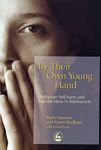
|
By
Their Own Young Hand: Deliberate Self-Harm and Suicidal Ideas in
Adolescents. Keith Hawton & Karen Rodham, $34.95
Self-harm in adolescents is an increasingly
recognized problem, and there is growing awareness of the important
role schools and health services can play in detecting and supporting
those at risk. By Their Own Young Hand explores the findings
of the first large-scale survey of deliberate self-harm and suicidal
thinking in adolescents in the UK, and draws out the implications
for prevention strategies and mental health promotion. |
|
Child and Adolescent
Suicidal Behavior: School-Based Prevention, Assessment, and Intervention.
David Miller, $33.95
Meeting a crucial need, this book distills the best current knowledge on child and adolescent suicide prevention into comprehensive guidelines for school-based practitioners. The author draws on extensive research and clinical experience to provide best-practice recommendations for developing school-wide prevention programs, conducting risk assessments, and intervening at different levels of intensity with students at risk. Also presented are post-intervention procedures for responding effectively if a suicide does occur. Legal and ethical issues are addressed in detail. |
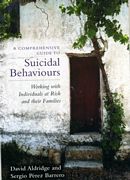
|
A Comprehensive Guide
to Suicidal Behaviours: Working with Individuals at Risk and Their
Families. David Aldridge & Sergio Pérez Barrero, $38.95
Taking an interdisciplinary approach
that looks at the person at risk, the family and personal relationships they
have and the communities in which they are embedded, this book will help anyone
working with suicidal individuals to prevent this major cause of death.
Backed up by research and clinical
expertise the book clarifies the facts about suicide and debunks the many
unfounded myths surrounding the subject. It covers the classifications and
manifestations of suicide, as well as the major risk factors, at-risk groups
and warning signs. Advice on effective communication and a repertoire of
strategies for distress management are offered, not only for supporting at-risk
individuals and those who have survived a suicide attempt, but also families
coping with bereavement. A final chapter explores the impact of the internet
and the digital age on both the propagation and prevention of suicide.
This book will be essential reading for
anybody working with people at risk of suicide, including clinicians,
therapists, psychologists, social and healthcare workers and volunteers working
in suicide prevention. |
Back to top
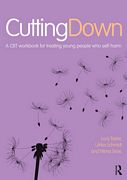
|
Cutting Down: a CBT Workbook for Treating Young People
Who Self-Harm. Lucy Taylor, Mima Simic & Ulrike Schmidt, $79.70
A quarter of adolescents engage in some form of self-harm
and even experienced therapists can find working with these young people
difficult. Based on Cognitive Behaviour Therapy (CBT), a highly effective
method for working with emotional problems, Cutting Down offers a
practical and accessible programme for mental health therapists from different
professional backgrounds working with young people who self-harm.
The programme is comprised of four parts, each covering a
specific stage of therapy, and is split into 27 short modules. Although
designed to be delivered over a course of 14 sessions, the programme is
presented in a way that allows the therapist to decide which combination of
specific modules is chosen and how long is spent on each, based on the specific
clinical needs of the person they are working with. Designed to support
clinicians working with adolescents engaging in self-harm, this unique workbook
is ideal for counsellors, counselling psychologists, clinical psychologists,
CBT therapists, IAPT practitioners, CAMHS mental health workers and nurse
therapists as well as students and trainees. |
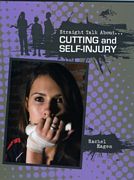
|
Cutting and Self Injury: Straight Talk. Rachel Eagen, $11.95 (grades 5-10)
Self-injury
is not something people talk about very often. Yet, it is a reality for
millions of young people across North America. This book deals with the
delicate issues of self-harming behavior and the reasons why people do it.
Directly and carefully written, this book discusses avoidance and treatment.
Special tool-box sections outline real life coping strategies for resisting,
and for helping friends and family cope with this real life issue. |
Back to top
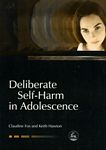
|
Deliberate
Self-Harm in Adolescence. Claudine Fox & Keith Hawton,
$34.95
This informative resource provides guidance for professionals and
parents caring for young people at risk of self-harm and suicide.
The authors, who are well-known in the field, consider what research
tells us about the increased prevalence of suicide and self-harm
among adolescents, including what the possible risk factors may
be. This thorough, practical and evidence-based book is essential
reading for all those who are working to support children and young
people at risk of self-harm and suicidal behaviour, including social
workers, psychiatrists and other mental health professionals, health
visitors, GPs, nurses, teachers and parents. |
|
Devastating Losses: How Parents Cope
with the Death of a Child to Suicide or Drugs. William
Ferguson, John Jordan, John McIntosh & Beverly Feigelman, $60.50
This book fills a critical gap in our
scientific understanding of the grief response of parents who have lost a child
to traumatic death and the psychotherapeutic strategies that best facilitate
healing. It is based on the results of the largest study ever conducted of
parents surviving a child's traumatic death or suicide. The book intertwines
data, insight, and critical learning gathered from research with the voices of
the 575 survivors who participated in the study.
The text emphasizes the sociological
underpinnings of survivors' grief and provides data that vividly documents
their critical need for emotional support. It explains how bereavement
difficulties can be exacerbated by stigmatization, and by the failure of
significant others to provide expected support. Also explored in depth are the
ways in which couples adapt to the traumatic loss of a child and how this can
bring them closer or render their relationship irreparable. Findings suggest
that with time and peer support affiliations, most traumatically bereaved
parents ultimately demonstrate resilience and find meaningful new roles for
themselves. |
|
The Girl Behind the Door: a Father's Quest to
Understand His Daughter's Suicide. John Brooks, $33.00
Early one Tuesday morning John Brooks went to his teenage
daughter’s room to make sure she was getting up for school and found her room
dark and “neater than usual.” Casey was gone but he found a note: The
car is parked at the Golden Gate Bridge. I’m sorry. Several hours later a
security video was found that showed Casey stepping off the bridge.
Brooks spent months after Casey’s suicide trying to understand what led his 17-year-old
daughter to take her life. He examines Casey’s journey from her abandonment at
birth in Poland, to the orphanage where she lived for the first fourteen months
of her life, to her adoption and life with John and his wife Erika in Northern
California. He reads. He talks to Casey’s friends, teachers, doctors,
therapists, and other parents. He consults adoption experts, researchers,
clinicians, attachment therapists, and social workers.
In The Girl Behind the Door, Brooks shares what he learned and asks
“What did everyone miss? What could have been done differently?” He’d come to
realize that Casey might have been helped if someone had recognized that she’d
likely suffered an attachment disorder from her infancy — an affliction common
among children who’ve been orphaned, neglected, and abused. This emotional
deprivation in early childhood, from the lack of a secure attachment to a
primary caregiver, can lead to a wide range of serious behavioral issues later
in life. John’s hope is that Casey’s story, and what he discovered since her
death, will help others. This important book is a wakeup call that parents,
mental health professionals, and teens should read. |
Back to top
|
Eight
Stories Up: an Adolescent Chooses Hope Over Suicide. Dequincy
Lezine, with David Brent, $10.95
Eight Stories Up is both a remarkable
memoir and a useful, compassionate guide that will ease the isolation
and hopelessness caused by thoughts of suicide. |

|
EMDR Solutions:
Pathways to Healing. Robin Shapiro, editor, $52.50 Chapter
by chapter, readers are introduced to key techniques based in the
powerful standard protocol of eye movement desensitization and reprocessing
(EMDR). The inventor of each technique explains and illustrates
his or her method using a variety of case examples. Mixing a how-to
approach with ample clinical wisdom, this book will help clinicians
excel when using EMDR to treat clients. |
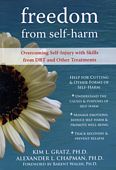
|
Freedom from Self-Harm:
Overcoming Self-Injury with Skills from DBT and Other Treatments.
Kim Gratz & Alexander Chapman, $22.95
Self-injury can be as addictive as any drug, and the secrecy and shame
many sufferers feel about this behavior can keep them feeling trapped.
This complete guide to stopping self-injury gives you the facts about
self-harm, corrects common myths this behavior, and provides self-soothing
techniques you can begin using right away for regulating difficult or
overwhelming emotions. Drawn from treatments such as dialectical behavior
therapy (DBT) and acceptance and commitment therapy (ACT), the tools
in this book can help you cope with your emotions whenever you feel the
urge to self-harm. |
|
Helping Children and Young People Who Self-Harm: an Introduction to Self-Harming and Suicidal Behaviours for Health Professionals. Tim McDougall, Marie Armstrong & Gemma Trainor, $46.50
Helping Children and Young People Who Self-Harm provides clear and practical guidance for health professionals and child and youth workers, who are confronted by this complex and difficult reality. |
Back to top
|
Helping Kids in Crisis: Managing Psychiatric
Emergencies in Children and Adolescents. Edited by Fadi Haddad & Ruth
Gerson, $74.50
Helping Kids in Crisis provides expert guidance to
practitioners responding to high-stakes situations, such as children
considering or attempting suicide, cutting or injuring themselves purposely,
and becoming aggressive or violently destructive. Children experiencing behavioral
crises frequently reach critical states in venues that were not designed to
respond to or support them — in school, for example, or at home among their
highly stressed and confused families. Professionals who provide services to
these children must be able to quickly determine threats to safety and initiate
interventions to deescalate behaviors, often with limited resources.
The
editors and authors have extensive experience at one of the busiest and best
regional referral centers for children with psychiatric emergencies, and have
deftly translated their expertise into this symptom-based guide to help
non-psychiatric clinicians more effectively and compassionately care for this
challenging population. |
|
Helping Teens Who Cut: Using DBT® Skills to End
Self-Injury, 2nd Edition. Michael Hollander, $23.50
Discovering that your teen “cuts” is every parent's
nightmare. Your most urgent question is: "How can I make it stop?"
Tens of thousands of worried parents have turned to this authoritative guide
for information and practical guidance about the growing problem of teen
self-injury. Dr. Michael Hollander is a leading expert on dialectical behavior
therapy (DBT), the most effective treatment approach for cutting. Vivid stories
illustrate how out-of-control emotions lead some teens to hurt themselves, how
DBT can help, and what other approaches can be beneficial. You'll learn
practical strategies for talking to teens about self-injury without making it
worse, teaching them skills to cope with extreme emotions in a healthier way,
finding the right therapist, and helping reduce stress for your whole family.
Incorporating the latest research, the second edition offers a deeper
understanding of the causes of self-injury and includes new DBT skills. |
|
History of a Suicide: My Sister’s Unfinished Life. Jill Bialosky, $27.99
An extraordinary book. Poetic, compassionate and courageous, History of a Suicide is an intimate look at suicide and a fearless, yet tender, account of family mythology and pain. Jill Bialosky brings to light an unspeakable act, and does so with a clarity that comes from years of reflection and turmoil. |
Back to top

|
Identifying, Assessing,
and Treating Self-Injury at School. David Miller, $58.95
Nonsuicidal self-injury (NSSI) among
young people — most notably in the form of forearm or wrist cutting — occurs
across cultural groups, social strata, and developmental stages, puzzling and
repelling adults. Because NSSI is often first noticed in the school setting (as
is the case with many children's disorders), school professionals are being
encouraged to take a more proactive role in intervention.
The book, which is specifically geared
toward education personnel, clearly defines NSSI, differentiating it from
suicidal, borderline, and other behaviors and analyzing the psychological
contexts in which it occurs. This school-based perspective gives readers a
practical framework for earlier, more accurate diagnosis; relevant consulting
with parents, teachers, and colleagues; and effective, science-based treatment. |
|
I'll Write Your Name On Every Beach: a Mother's Quest
for Comfort, Courage, and Clarity After Suicide Loss. Susan Auerbach,
$22.95
Written by a mother who lost her 21-year-old son to
suicide, this book deals with the themes of suicide loss through the lens of
the author's personal grief. Addressing the process of post-traumatic growth,
this memoir provides the bereaved with therapy exercises and creative
activities to help them come to terms with their loss.
Although it deals directly with losing a child, much of
the book pertains to grief generally, especially complicated grief after a
sudden death, and thus provides comfort to any reader who has lost a close one
to suicide or anyone interested in young people struggling with mental health.
Organised thematically, it addresses the many issues and stages involved in the
grieving process and ends each chapter with a variety of beneficial yoga,
breathing and therapy activities. This allows readers to dip in and out of the
book, and go at their own pace - replicating the fact that grief is not a
linear journey but an iterative one that goes back and forth. This book is a
lifeline for anyone struggling to process loss. |
|
Living through Suicide Loss with an Autistic Spectrum
Disorder: an Insider Guide for Individuals. Family, Friends and Professional
Responders. Lisa Morgan, $27.95
Losing someone to suicide can open up a world of pain,
confusion and grief, and for people with ASDs, the effect can be acute and
extremely challenging. Reaching out to fellow Aspies, Lisa Morgan proffers her
insight and advice to ensure that others on the autism spectrum don't have to
face suicide loss alone.
Written from a first-hand account, this astonishingly
honest book looks at the immediate aftermath, and how emergency responders can
help, as well as the long-term implications of living with suicide loss for
individuals on the autism spectrum. The book describes common difficulties
after experiencing suicide loss, such as beginning to comprehend the death of a
loved one and managing their estate, as well as matters more specific to people
on the autism spectrum, such as overstimulated sensory issues and difficulties
with misunderstandings and miscommunication at an already chaotic time. The
book will also help those who aren't on the autism spectrum to understand how
best to help someone with autism who is coping with suicide loss, as well as
what not to do. |
Back to top

|
Living When
a Young Friend Commits Suicide or Even Starts Talking about It.
Earl Grollman & Max Malikow, $19.00
Earl Grollman is an internationally recognized grief counselor and
author known for his work with children and teens; Max Malikow is
a pastoral counselor. Together they have written a unique book for
young friends or relatives affected by suicide. A straightforward
and compassionate book, Living When a Young Friend Commits Suicide
gives comfort and expert ideas for adolescents and young adults, answering
the many questions that arise out of their grief, confusion, anger
and fear. |
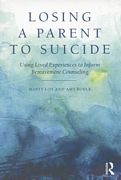
|
Losing a Parent to Suicide: Using
Lived Experiences to Inform Bereavement Counseling. Marty Loy & Amy Boelk, $47.50
The suicide of a parent has life-long
consequences; few more traumatic scenarios exist, and counselors often struggle
for ways to help clients deal with its effects. Few understand the pain and
life-altering effects of these tragedies better than children who have
experienced the suicide of a parent. Despite this, there are few texts that
incorporate and evaluate the first-person accounts of grief following a suicide
while advancing a method for helping. LOSING A PARENT TO
SUICIDE analyzes stories of parent suicides and explores the grief and
coping processes that follow, discovering the strategies, methods and modes of
therapy that have empowered grieving individuals and helped them rebuild their
lives. |
|
Luna's Red Hat: an Illustrated Storybook to Help
Children with Loss and Suicide. Emmi Smid, $20.95
It is a beautiful spring day, and Luna is having a picnic
in the park with her family, wearing her Mum's red hat. Luna's Mum died one
year ago and she still finds it difficult to understand why. She feels that it
may have been her fault and worries that her Dad might leave her in the same
way. Her Dad talks to her to explain what happened and together they think
about all the happy memories they have of Mum.
Charmingly-illustrated, this storybook is designed to be
read with children aged 6+ who have been bereaved by suicide, to help them cope
with their difficult feelings. The book also includes a guide for parents and
professionals by grief expert, Dr Riet Fiddelaers-Jaspers. |

|
No Time to
Say Goodbye: Surviving the Suicide of a Loved One. Carla Fine,
$21.00
Drawing on her own experience, the experiences of the many other survivors
with whom she has spoken and the knowledge of counselors and mental
health professionals, Carla Fine offers compassionate guidance through
the various stages of mourning a loss by suicide. |
Back to top
|
|
Play Therapy with Children and Adolescents in Crisis,
4th Edition. Edited by Nancy Boyd Webb, $68.95
This widely used practitioner resource and course text is
considered the most comprehensive guide to working with children who have
experienced major losses, family upheavals, violence in the school or
community, and other traumatic events. Leading experts present a range of play
and creative arts therapy techniques in chapters organized around in-depth case
examples. Informed by the latest knowledge on crisis intervention and trauma,
the book now encompasses work with adolescents as well as younger children.
Each chapter concludes with instructive questions for study or reflection. |
|
Rafi's Red Racing Car: Explaining Suicide and Grief to
Young Children. Louise Mohr, $25.95 (ages 3-8)
This beautiful, sensitively composed storybook is a
valuable resource for both children affected by a family member's suicide and
their carers. Through a creative, heart-warming tale about a young grieving
rabbit named Rafi, it gently explains the truth about death and suicide while
communicating that everything will eventually be okay again. |
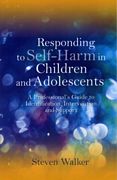
|
Responding to Self-Harm
in Children and Adolescents: a Professional's Guide to Identification,
Intervention and Support. Steven Walker, $28.95
Self-harm is a growing problem in
children and young people but it can be hard to understand and difficult to recognize.
RESPONDING TO SELF-HARM IN CHILDREN AND
ADOLESCENTS will help professionals to understand self-harm and respond
appropriately. It covers what the risk factors are, including social exclusion,
and who is most likely to self-harm. Information on what self-harm is and what
causes it, including mental health issues, problems in childhood and trauma, is
included. The book also covers how to recognize self-harm and how to
immediately respond in an emergency, and different intervention methods are
explored. Finally, the author discusses means of support, including how parents
and friends can help.
This accessible guide provides clear and
easily digestible information and practical advice to any professional working
with a child or young person who is suspected of, or actually self-harming. |
|
Rocky Roads: the Journeys of Families
through Suicide Grief. Michelle Linn-Gust, $21.95
ROCKY ROADS guides individuals and
families, with the ultimate goal of strengthening the family, after a suicide
loss. Author Michelle Linn-Gust recognizes that each person’s journey is
unique, yet happens within the context of family histories, traditions, and
relationships. With compassion and experience, she offers a family-based
perspective to suicide loss. |
Back to top
|
Self-Harm and Eating Disorders in Schools: a Guide to
Whole-School Strategies and Practical Support. Pooky Knightsmith, $31.95
Self-harm and eating disorders are present in almost
every school and they frequently co-occur. This book provides the vital
guidance that school staff need to spot early warning signs, understand
triggers and support the students in their care effectively.
This very practical guide helps educational professionals to gain a better
understanding of self-harm and eating disorders by dispelling the myths and
misconceptions that surround these behaviours. The book provides advice on
whole-school policies and procedures as well as day-to-day strategies to
implement in lessons, at mealtimes and in one-on-one sessions. It explains how
to respond to disclosures, make referrals and work alongside parents to assist
in the road to recovery. |
|
Self-Injury in Youth: the Essential Guide to
Assessment and Intervention. Mary Nixon & Nancy Heath, $63.95 
This edited volume features evidence-based reviews and
practical approaches for the professional in the hospital, clinic, community
and school, with case examples throughout. Divided into five major sections,
the book offers background historical and cultural information, discussion of
self-injury etiology, assessment and intervention/prevention issues, and
relevant resources for those working with youths who self-injure. |
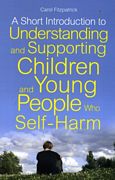
|
A Short Introduction to Understanding and
Supporting Children and Young People Who Self-Harm. Carol Fitzpatrick, $22.95
Self-harm and suicidal behaviours are
increasingly common in young people, but are often hidden. It can be hard to
know what might be causing a young person to self-harm, and how to help and
support them. Practical and easy to read, this book guides the reader through
what self-harm is, how to recognize it, and how best to respond. It combines
case studies with professional and practical advice, covering all aspects from
warning signs and treatment to communication and how the family is affected.
The author also emphasizes the importance of parents and carers seeking support
for themselves.
This book is an invaluable source of
information and guidance for parents, teachers, youth workers, and others who
care for a young person showing signs of self-harm or suicidal behaviour. |
Back to top
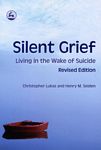
|
Silent Grief: Living in the Wake of Suicide, Revised Edition.
Christopher Lukas & Henry Seiden, $22.95
Silent Grief is a book
for and about “suicide survivors” – those who have been left behind
by the suicide of a friend or loved one. Author Christopher Lukas
is a suicide survivor himself — several members of his family have
taken their own lives — and the book draws on his own experiences,
as well as those of numerous other suicide survivors. These personal
testimonies are combined with the professional expertise of Henry
M. Seiden, a psychologist and psychoanalytic psychotherapist.
The authors present information on common
experiences of bereavement, grief reactions and various ways of
coping. Their message is that it is important to share one's experience
of “survival” with others and they encourage survivors to overcome
the perceived stigma or shame associated with suicide and to seek
support from self-help groups, psychotherapy, family therapy, Internet
support forums or simply a friend or family member who will listen.
Silent Grief gives valuable
insights into living in the wake of suicide and provides useful
strategies and support for those affected by a suicide, as well
as professionals in the field of psychology, social work, and medicine. |
|
|
Stopping the Pain:
a Workbook for Teens Who Cut & Self-Injure. Lawrence
Shapiro, $24.95
If you are cutting or hurting yourself,
you are not alone.
The exercises in Stopping the Pain will help you explore why you self-injure and give you ideas on
how you can stop. The book will help you learn new skills for dealing
with issues in your life, reduce your stress and to reach out to
others when you need to. Work through this book or just check out
the sections that speak to you most. This is your own personal and
private road map to regaining control of your life.
Stopping the Pain: a Workbook for Teens Who
Self-Injure. Lawrence Shapiro, Professional Version with
CD-ROM, $36.95
Self-injury can be a symptom of a variety
of disorders, but no matter what the cause, this disturbing behavior
must be addressed. This comprehensive workbook helps the teen and
her counselor explore the reasons behind her need to hurt herself,
and focuses on more positive ways to deal with the issues of stress
and control. The professional version includes the workbook and
a digital copy of the workbook on CD-ROM for easy printing. |
Back to top
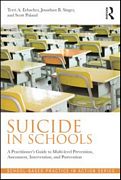
|
Suicide in Schools: a Practitioner's Guide to
Multi-level Prevention, Assessment, Intervention, and Postvention. Terri
Erbacher, Jonathan Singer & Scott Poland, $53.95
Suicide in Schools provides school-based
professionals with practical, easy-to-use guidance on developing and
implementing effective suicide prevention, assessment, intervention and
postvention strategies. Utilizing a multi-level systems approach, this book
includes step-by-step guidelines for developing crisis teams and prevention
programs, assessing and intervening with suicidal youth, and working with
families and community organizations during and after a suicidal crisis. The
authors include detailed case examples, innovative approaches for professional
practice, usable handouts, and internet resources on the best practice
approaches to effectively work with youth who are experiencing a suicidal
crisis as well as those students, families, school staff, and community members
who have suffered the loss of a loved one to suicide.
Readers will come away
from this book with clear, step-by-step guidelines on how to work proactively
with school personnel and community professionals, think about suicide
prevention from a three-tiered systems approach, how to identify those who
might be at risk, and how to support survivors after a traumatic event, all in
a practical, user-friendly format geared especially for the needs of
school-based professionals. |
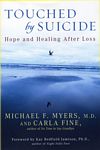
|
Touched
by Suicide: Hope and Healing After Loss. Michael Myers &
Carla Fine, $17.50
In this definitive guide book, Michael F. Myers, MD, a leading
psychiatrist, and Carla Fine, author of the acclaimed No Time
to Say Goodbye: Surviving the Suicide of a Loved One, combine
their perspectives as a physician and a survivor to offer compassionate
and practical advice to anyone affected by suicide. |
Back to top
|
Treating Depressed and Suicidal Adolescents: a Clinician's Guide. David Brent, Kimberly Poling & Tina Goldstein, $38.50
Grounded in decades of research and the clinical care of thousands of depressed and suicidal teens, this highly accessible book will enhance the skills of any therapist who works with this challenging population. The authors describe the nuts and bolts of assessing clients and crafting individualized treatment plans that combine cognitive and behavioral techniques, emotion regulation interventions, family involvement, and antidepressant medication. Illustrated with many clinical examples, each chapter includes a concise overview and key points. Reproducible treatment planning forms and client handouts can also be downloaded and printed by purchasers in a convenient full-page size. |
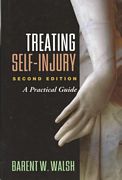
|
Treating Self-Injury, 2nd Edition: a
Practical Guide. Barent Walsh, $49.50
This trusted practitioner resource is
acclaimed for its clear, compassionate, and hopeful approach to working with
clients who self-injure. Barent Walsh provides current, evidence-based
knowledge about the variety and causes of self-injurious behavior, its
relationship to suicidality, and how to assess and treat it effectively.
Illustrated with detailed case examples, chapters review a wide range of
cognitive-behavioral interventions. Essential guidance is provided on tailoring
the intensity of intervention to each client's unique needs. Walsh is joined by
several colleagues who have contributed chapters in their respective areas of
expertise. |
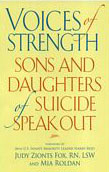
|
Voices of Strength: Sons and Daughters of Suicide Speak Out. Judy Zionts Fox & Mia Roldan, $17.50
In this deeply moving book, Judy Zionts Fox and Mia Roldan survey survivors of parental suicide, exploring they ways their lives have been affected and shaped by this life-altering event. The authors, themselves both victims of parental suicide, help fellow survivors to gain comfort, cope with memories of their departed parents and reveal helpful methods and strategies by which to heal from the heartbreak of parental suicide and create a promising, productive future. |
Back to top
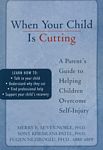
|
When
Your Child is Cutting: a Parent’s Guide to Helping Children Overcome
Self-Injury. Merry McVey-Noble, Sony Khemlani-Petal, Fugen
Neziroglu, $24.95
When Your Child is Cutting tells parents
why self-injury happens, how to spot it when it is happening, and
how to address this sensitive topic with confidence. It outlines
a clear and simple plan for approaching a child who self-injures-because
good communication is a necessary first step in healing. By helping
them assess their situation and locate the best kinds of professional
help, this book strives to support and reassure parents as they
move through this difficult experience. |
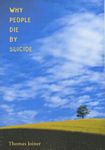
|
Why People
Die by Suicide. Thomas Joiner, $22.50
Drawing on extensive clinical and epidemiological
evidence, as well as personal experience, Thomas Joiner brings a
comprehensive understanding to seemingly incomprehensible behavior.
Among the many people who have considered, attempted, or died by
suicide, he finds three factors that mark those most at risk of
death: the feeling of being a burden on loved ones; the sense of
isolation; and, chillingly, the learned ability to hurt oneself.
Joiner tests his theory against diverse facts taken from clinical
anecdotes, history, literature, popular culture, anthropology, epidemiology,
genetics, and neurobiology - facts about suicide rates among men
and women; white and African-American men; anorexics, athletes,
prostitutes, and physicians; members of cults, sports fans, and
citizens of nations in crisis.
The result offers insight, guidance, and essential
information to clinicians, scientists, and health practitioners,
and to anyone whose life has been affected by suicide.
|
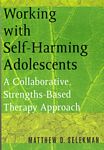
|
Working
with Self-Harming Adolescents: a Collaborative, Strengths-Based Therapy
Approach. Matthew D. Selekman, $29.00
Matthew Selekman provides readers with a comprehensive, highly
practical approach to working with a challenging group of clients
— adolescents who self-harm. Mental health professionals and affiliated
professionals in schools are seeing more and more adolescents who
cut and burn themselves, abuse alcohol and drugs, have eating disorders,
or who engage in excessive risk taking. Working with Self-Harming
Adolescents offers readers effective guidelines for preventing
and constructively managing self-harming episodes. The book offers
an integrative and flexible solution-oriented approach for treatment
and an innovative, skill-based Stress-Busters’ Leadership Group,
which can be run in schools or any treatment setting
|
Back to top
Complete
Booklist
Resources for Professionals
Adolescent Self-Injury: a Comprehensive Guide for Counselors
and Health Care Professionals. Amelio D’Onofrio, $63.50
Adolescent Suicide: Assessment and Intervention.
Alan Berman & David Jobes, $22.50
The Adolescent & Young Adult Self-Harming
Treatment Manual: a Collaborative Strengths-Based Brief Therapy Approach.
Mathew Selekman, $42.50
After the Storm: Healing after Trauma, Tragedy
and Terror. Kendall Johnson, $19.50
After the Suicide: Helping the
Bereaved to Find a Path from Grief to Recovery. Kari
Dyregrov, Einar Plyhn & Gudrun Dieserud, $31.95
Bleeding to Ease the Pain: Cutting, Self-Injury and the Adolescent Search for Self. Lori Plante, $22.95
A
Bright Red Scream: Self-Mutilation and the Language of Pain.
Marilee Strong, $22.00
By Their Own Young Hand: Deliberate Self-Harm
and Suicidal Ideas in Adolescents. Keith Hawton & Karen Rodham, $34.95
Child and Adolescent Suicidal Behavior: School-Based Prevention,
Assessment, and Intervention. David Miller, $33.95
Cognitive-Behavioral Strategies in Crisis Intervention.
Frank Dattilio & Arthur Freeman, $73.95
Comprehensive Emergency Mental Health Care.
Joseph Zealberg et al, $50.00
A Comprehensive Guide to Suicidal Behaviours: Working with
Individuals at Risk and Their Families. David Aldridge & Sergio Pérez
Barrero, $38.95
Creating Excellence in Crisis Care: a Guide
to Effective Training and Program Designs. Lea Ann Hoff & Kazimiera
Adamowski, $57.50
Crisis Intervention: Theory and Methodology,
7th Edition. Donna Aguilera, $54.95
Cross Cultural Caring: a Handbook for Health
Professionals, 2nd edition. Nancy Waxler-Morrison $29.95
Cutting Down: a CBT Workbook for Treating Young People
Who Self-Harm. Lucy Taylor, Mima Simic & Ulrike Schmidt, $79.70
Deliberate Self-Harm in Adolescence. Claudine
Fox & Keith Hawton, $34.95
Devastating Losses: How Parents Cope
with the Death of a Child to Suicide or Drugs. William
Ferguson, John Jordan, John McIntosh & Beverly Feigelman, $60.50
EMDR Solutions: Pathways to Healing. Robin
Shapiro, editor, $52.50
Back to top
Family Based Services: a Solution-Focused Approach.
Insoo Kim Berg, $36.99
Freedom from Self-Harm: Overcoming Self-Injury with Skills
from DBT and Other Treatments. Kim Gratz & Alexander Chapman, $22.95
Helping
Children Cope with Disasters and Terrorism. Annette la Greca, et al,
editors. $66.50
Helping Children and Young People Who Self-Harm: an Introduction to Self-Harming and Suicidal Behaviours for Health Professionals. Tim McDougall, Marie Armstrong & Gemma Trainor, $46.50
Helping Kids in Crisis: Managing Psychiatric
Emergencies in Children and Adolescents. Edited by Fadi Haddad & Ruth
Gerson, $74.50
Identifying, Assessing, and Treating Self-Injury at School.
David Miller, $58.95
Losing a Parent to Suicide: Using
Lived Experiences to Inform Bereavement Counseling. Marty Loy & Amy Boelk, $47.50
People in Crisis: Understanding and Helping,
4th Edition. Lee Ann Hoff, $59.95
Play Therapy with Children and Adolescents in Crisis,
4th Edition. Edited by Nancy Boyd Webb, $68.95
Responding to Self-Harm in Children and Adolescents: a
Professional's Guide to Identification, Intervention and Support. Steven
Walker, $28.95
Risk Management with Suicidal Patients. Bruce
Bongar et al. (eds), $33.95
A Slender Thread: Rediscovering Hope at the
Heart of Crisis. Diane Ackerman, $21.00
Suicide in Canada.
Antoon Leenaars et al. (eds), $29.95
Suicide in Children and Adolescents. Robert
King, et al, $76.95
Treating Depressed and Suicidal Adolescents: a Clinician's Guide. David Brent, Kimberly Poling & Tina Goldstein, $38.50
Treating Self-Injury, 2nd Edition: a
Practical Guide. Barent Walsh, $49.50
Where to Start and What to Ask: an Assessment
Handbook. Susan Lukas, $22.99
Working with Self-Harming Adolescents: a Collaborative,
Strengths-Based Therapy Approach. Matthew D. Selekman, $29.00
Back to top
Resources for Families (* Kids / ** Teens)
After a Parent’s Suicide: Helping Children Heal. Margo
Requarth, $22.95
After a Suicide: a Workbook for Grieving Kids.
The
Dougy Center, $18.95
Ask Me: 30 Things I Want You to Know - How to Be a Friend
to a Survivor of Suicide. Nan Zastrow, $6.75
Bloodletting:
a Memoir of Secrets, Self-Harm & Survival. Victoria
Leatham, $19.95
But I Didn’t Say Goodbye: for Parents and Professionals
Helping Child Suicide Survivors. Barbara Rubel, $18.95
* **Cutting and Self Injury: Straight Talk. Rachel Eagen, $11.95 (grades 5-10)
Eight Stories Up: an Adolescent Chooses Hope
Over Suicide. Dequincy Lezine, with David Brent, $10.95
Facing Change: Falling Apart and Coming Together Again
in the Teen Years: a Book about Loss and Change for Teens. Donna O’Toole,
$10.95
The Girl Behind the Door: a Father's Quest to
Understand His Daughter's Suicide. John Brooks, $33.00
Healing after the Suicide of a Loved One. Ann
Smolin & John Guinan, $21.00
Help me, I'm Sad: Recognizing, Treating, and Preventing
Childhood and Adolescent Depression. David Fassler & Lynne Dumas,
$16.50
Helping Teens Who Cut: Using DBT® Skills to End
Self-Injury, 2nd Edition. Michael Hollander, $23.50
History of a Suicide: My Sister’s Unfinished Life. Jill Bialosky, $27.99
How I Stayed Alive When My Brain Was Trying
to Kill Me: One Person’s Guide to Suicide Prevention. Susan Rose Blauner,
$19.95
**Hurting Yourself: for Young People Who have Attempted
Suicide or Intentionally Hurt Themselves. Jeanne Harper, $4.00
I Wasn’t Ready to Say Goodbye: a Companion
Workbook for Surviving, Coping & Healing After the Sudden Death of
a Loved One. Brook Noel, $21.95
I'll Write Your Name On Every Beach: a Mother's Quest
for Comfort, Courage, and Clarity After Suicide Loss. Susan Auerbach,
$22.95
In the Wake of Suicide: Stories of the People
Left Behind. Victoria Alexander, $37.50
Living through Suicide Loss with an Autistic Spectrum
Disorder: an Insider Guide for Individuals. Family, Friends and Professional
Responders. Lisa Morgan, $27.95
**Living When a Young Friend Commits Suicide:
Or Even Starts Talking about It. Earl A. Grollman & Max Malikow, $19.00
Lonely, Sad and Angry: a Parent's Guide to
Depression in Children and Adolescents. Barbara Ingersoll & Sam Goldstein,
$16.95
*Luna's Red Hat: an Illustrated Storybook to Help
Children with Loss and Suicide. Emmi Smid, $20.95
Mental Illness in the Family: Issues and Trends.
Beverley Abosh & April Collins, $16.95
My Son, My Son: a Guide to Healing After Death,
Loss or Suicide. Iris Bolton, $16.95/Audio Cassette (4), $48.95
Back to top
Night Falls Fast: Understanding Suicide. Kay
Redfield Jamison, $21.00
**No One Saw My Pain: Why Teens Kill Themselves.
Andrew Slaby & Lili Frank Garfinkel, $19.00
No Time for Goodbyes: Coping with Sorrow, Anger
and Injustice After a Tragic Death. Janice Harris Lord, $15.95
No Time to Say Goodbye: Surviving the Suicide of a Loved
One. Carla Fine, $21.00
**Out of the Shadows: a Journal for Teens Who Have Someone
They Love Complete Suicide. Emilio Parga, $11.95
**The Power to Prevent Suicide: a Guide for Teens Helping
Teens. Richard Nelson & Judith Galas, $15.50
*Rafi's Red Racing Car: Explaining Suicide and Grief to
Young Children. Louise Mohr, $25.95 (ages 3-8)
Rocky Roads: the Journeys of Families
through Suicide Grief. Michelle Linn-Gust, $21.95
Self-Harm and Eating Disorders in Schools: a Guide to
Whole-School Strategies and Practical Support. Pooky Knightsmith, $31.95
Self-Injury in Youth: the Essential Guide to
Assessment and Intervention. Mary Nixon & Nancy Heath, $63.95
A Short Introduction to Understanding and
Supporting Children and Young People Who Self-Harm. Carol Fitzpatrick, $22.95
Silent Grief: Living in the Wake of Suicide,
Revised Edition. Christopher Lukas & Henry Seiden, $22.95
Stopping the Pain: a Workbook for Teens Who Cut &
Self-Injure. Lawrence Shapiro, $24.95
Suicide in Schools: a Practitioner's Guide to
Multi-level Prevention, Assessment, Intervention, and Postvention. Terri
Erbacher, Jonathan Singer & Scott Poland, $53.95
Suicide of a Child: for Parennts Whose Child
Has Completed Suicide. Adina Wrobleski, $3.95
Suicide Survivors' Handbook: a Guide for the
Bereaved and Those Who Wish to Help Them. Trudy Carlson, $22.95
Surviving the Death of a Sibling: Living through
Grief When an Adult Brother or Sister Dies. T.J. Wray, $23.00
**A Teenager’s Book about Suicide: Helping
Break the Silence and Preventing Death. Earl Grollman & Joy Johnson,
$6.50
Touched by Suicide: Hope and Healing After
Loss. Michael Myers & Carla Fine, $17.50
Understanding Anger During Bereavement. Bob
Baugher, et al, $12.50
Understanding Your Suicide Grief: Ten Essential
Touchstones for Finding Hope and Healing Your Heart. Alan Wolfelt, $15.95
**When a Friend Dies: a Book for Teens about Grieving &
Healing. $11.99
When Someone You Love Completes Suicide. Sondra Sexton-Jones,
$6.95
When Your Child is Cutting: a Parent’s Guide
to Helping Children Overcome Self-Injury. Merry McVey-Noble, Sony Khemlani-Petal,
Fugen Neziroglu, $24.95
Who Lives Happily Ever After? For Families
Whose Child Has Died Violently. Sharon Turnball, $3.50
Why People Die by Suicide. Thomas Joiner, $22.50
Why Suicide? Answers to 200 of the Most Frequently
Asked Questions about Suicide, Attempted Suicide and Assisted Suicide.
Eric Marcus, $20.95
Will’s Choice: a Suicidal Teen, a Desperate
Mother and a Chronicle of Recovery. Gail Griffith, $19.95
Back to top

Didn't
find it...?
Not sure...?
Need a suggestion...?
There are over 10,000 titles listed on our website and more than 35,000 titles in our inventory. If you haven't found what you want on the website — and it's one of our specialties — chances are good that we carry it, or can get it for you. Just let us know what you're looking for.
Call us toll-free 1-800-209-9182
or e-mail
PARENTBOOKS is pleased to invoice institutions.
Please inquire regarding terms and discounts. Shop in person, by phone,
fax, mail or e-mail. VISA, Mastercard and Interac are welcome. We are
open from 10:30 to 6:00 Monday through Saturday.
 All prices are in Canadian dollars
and are subject to change without notice. All prices are in Canadian dollars
and are subject to change without notice.

|